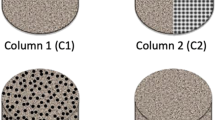Abstract
The effective diffusion coefficient of radon was determined in polymer/silicate gels and clay suspension used as sealing materials in environmental protection. On the basis of the experimental findings, it was concluded that both materials drastically decrease the convective mass transport in porous media. Simultaneously, the effective diffusion coefficient was reduced significantly. Thus, the radon flux might be decreased by 5 to 6 orders of magnitude in porous systems originally having gas or low water saturation by injection of gel-forming materials or placement of clay suspensions. At high water saturation, however, the diffusion transport of radon can be slightly restricted in consolidated and unconsolidated porous media. The laboratory studies may firmly allow us to conclude that hydrogels and clay suspensions are prospective candidates in an integrated environmental technology to be used for restriction of radon migration in subsurface regions.
Similar content being viewed by others
References
National Radiological Protection Board, United Kingdom: 1993, Natural Radiation Map of Western Europe, Information Folder.
Keshian B. and Bone M.: 1985, Publ. Univ. Arizona, p. 145.
McCorkell R. H. and Silver M.: 1987, CIM Bulletin 80, 43.
Fleischer R. L. and Likes R. S.: 1979, Geophysics 44, 1963.
Archibald J. F. and Hackwood H. J.: 1987, CIM Bulletin 80, 39.
Lakatos I. and Bauer K.: 1992, 4th Symp. on Mining Chemistry, Kiev, Proc., p. 85.
Nielson K. K., Rogers V. C. and Gee G. W.: 1984, Soil Sci. Soc. Am. J. 48, 482.
Loureiro C. O., Abriola L. M., Martin J. E. and Sextro R. G.: 1990, Environ. Sci. Technol. 24, 1338.
Tufail M., Mirza S. M., Chughtai M. K., Ahmad N. and Khan H. A.: 1991, Nucl. Tracks Rad. Measurements 19, 427.
Ramola R. C., Singh M., Singh S. and Virk H. S.: 1991, Nucl. Tracks Rad. Measurements 19, 389.
Mrnustik J. and Kominek A.: 1990, J. Environ. Radioactivity 12, 121.
Csige I., Hakl J. and Lakatos I.: 1995, Radiation Measurements 25, 659.
Pirson S. J.: 1958, Oil Reservoir Engineering, McGraw-Hill, New York.
Dullien F. A. L.: 1992, Porous Media: Fluid Transport and Pore Structure, Academic Press, New York.
Lakatos I. and Lakatos-Szabó, J.: 1996, Magyar Kémiai Folyóirat 102, 491.
Jost W.: 1957, Diffusion-Methoden der Messung und Auswertung, D. Steinkopff Verlag, Darmstadt.
Lakatos I. and Lakatos-Szabó, J.: 1995, Magyar Kémiai Folyóirat 101, 517.
Hirst W. and Harrison G. E.: 1939, The diffusion of radon gas mixtures, Proc. Royal Soc. 169.
Bird R. B., Stewart, W. E. and Lightfoot, E. N.: 1960, Transport Phenomena, Wiley, New York.
Author information
Authors and Affiliations
Rights and permissions
About this article
Cite this article
LAKATOS, I., BAUER, K., LAKATOS-SZABÓ, J. et al. Diffusion of Randon in Porous Media Saturated with Gels and Emulsions. Transport in Porous Media 27, 171–184 (1997). https://doi.org/10.1023/A:1006564200829
Issue Date:
DOI: https://doi.org/10.1023/A:1006564200829




